The Thai Market
 Wednesday, April 15, 2009 at 10:10AM
Wednesday, April 15, 2009 at 10:10AM A Walk in the Thai Market
Realism is the impossible attempt to view the world from Nowhere.
- Richard Rorty
Thailand, like most of the world, is beginning to be engulfed by the so-called global economy and the concomitant standardization of commercial space. Marketing plan driven corporate purchasing environments are the absolute antithesis of the Thai market, so far. The Thai market is a free-formed, organic, non-linear coming together of material items for sale, people, and culture . . . as well as light and shadow. The photographs that follow make clear that the light and shadow one encounters on a walk in the market tell a larger story; A story that will be different for each viewer, in the same way that the experience of the market for those who participate in its daily assembly and disassembly have different lives lived in its crowded confines that make each of their stories different, one from the other.
To walk in the market in Thailand is to be given the opportunity to ponder larger questions. It is a seemingly unavoidable necessity for the market visitor, first timer or old hand, to ask questions about what is being seen; to make sense. This compulsive drive for sense-making is not unique to the market, but is common whenever there is an encounter with other complex visual landscapes, such as the jungle, the coral reef, the human face. Upon entering the market there is, all of a sudden, so much unanticipated subject and object to think about. So much to feel; Information to process; Comparisons to be made; Differences to note and notice; Commentary to express. Your mind becomes as busy as the market environment itself. There around you are the strong images, arrangements, poses, still life portraits in the real, as it were, meant, you feel, for filing away in your visual memory to draw upon when the need for a memory of beauty is needed. You pay attention. You walk. Questions are begged. You think:
How has a thing come to be the way it is? How have all the forces of the universe so combined that such a thing is as it is?
-- James Agee
The mind of the market wanderer is full of wondering: What is going on here? What is going on here is not held in secret. Far from it, it is as explicit and overt as a freshly cracked ripe durian. To walk in the market is to find yourself asking questions. Making plans. Organizing thought. A study must be conducted. Curiosity must be formalized, one thinks, to get at what is so plainly present. An elevated discourse must be constructed, you say to yourself, to do justice to the people and place. Some comprehensive story must be made up, no mater how generalized it may start off. What is really going on here. The practical and the spiritual are to be found here. Everything that a person living in Thailand will want to buy is on sale. What is need to make or fix, wash or scrub, prepare or cook; every thing that supports or amuses, or is necessary for humans, or fancied by them, is here. The stuff of all local tastes and desires are to be found in the market. The questions arise, you walk, you think.

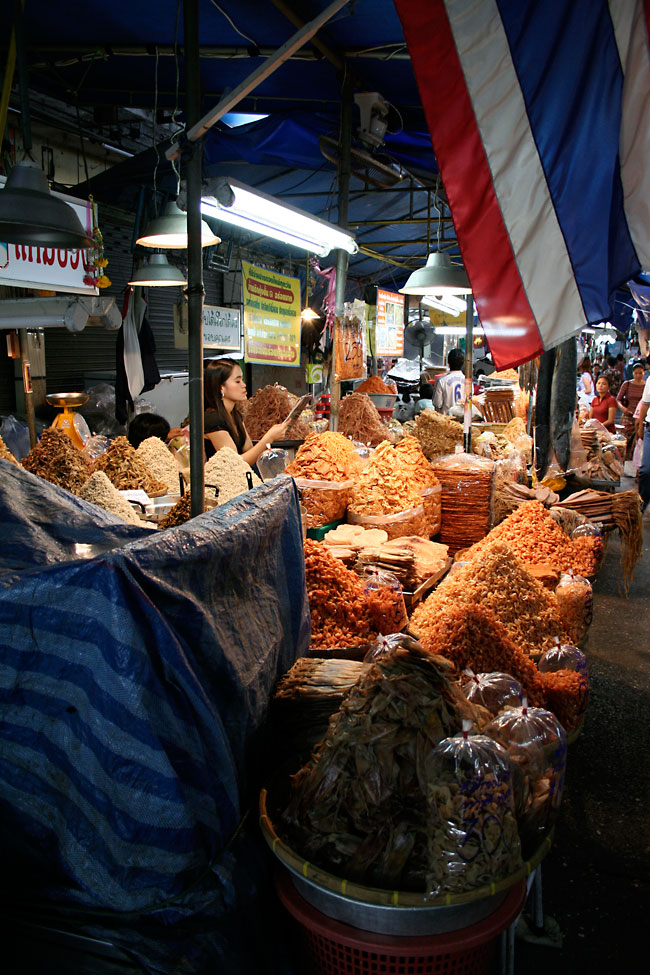
The Thai market is an abstract montage of things to look at and buy. The window dresser's calculus of knowing where to place an item to increase the likelihood of purchase seems shrouded in an ancient mystery here. The apparent jumble must surely relate to how a customer deduces a plan to find what is to be bought on any particular trip to the market. Or, at the very least, the arrangement must seem to the passer-by to be an irresistible inducement to set into motion the proverbial impulse purchase. There must be a logic, one assumes, to the arrangement of these things in space. Wouldn't there be? Wouldn't there have to be? The exact combination of what one particular petit commercant has on offer (on shelf, tub, hook, pan, basket) must surely relate to some locally agreed upon conceptualization of what goes together in order to help the purchaser find what they are looking for. But the sudden awareness you can have in the market when confronted with cheese framed faucets, cucumbers resting on rat traps, and the ubiquity-busting melons astride bras, is that perhaps no plan exists. You have to be a very smart shopper here.
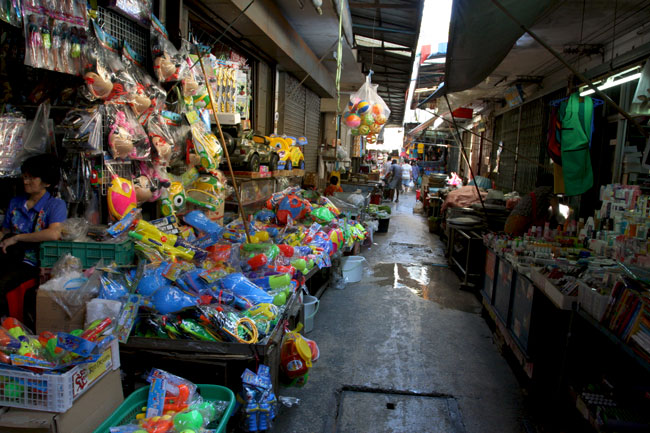
Arrayed in lines, circles, bundles, braids, entwinements, enwrapments, with and without geometry, you have the complete thesaurus' accounting of "display" and "array" in applied form right in front of you. And new ways of displaying, one suspects, being added daily as a result of the creative moments only one who sits in a hot market needing to make a sale to pay the bills would have. Or maybe not. Or maybe, it can look like, on a particular walk in the market, that the norm of display is the avoiding of conscious input into "promotion" of any item. That such a conscious intending would drive away the customer with hair-trigger resentments at being identified simply as a vulgar customer; a thing to buy a thing; other than human; qualified and identified by what is in a wallet or purse. What conventions are at work here on this day? What shared understandings about humanity are at work in the Thai market. How much spoken, how much left unsaid.
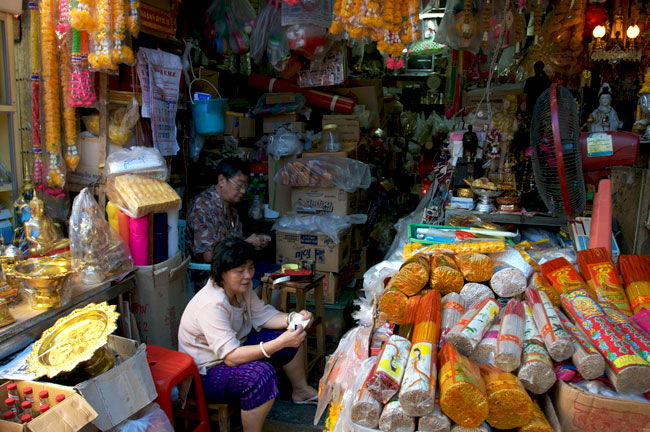
How does what gets offered on shelf, tub, hook, pan, basket, and cart get offered for sale, and why? How do the small merchants make sense of the market? Are bobbins and croissants side-by-side because of the observed rapid sales of such items? Is this market response? What theory guides these choices? Cheap availability only? Salesmen-promised big profits fast without risk and no obligation sign here now? Supply and demand? Surely not. There must be as many explanations for how what ended up on which cart, table, or tub as there are sellers in the market. Or, maybe, there are only a few ways to account for it. A simple set of forces that guide all these individual choices. Perhaps not.

What characterizes the Thai market is the reality of human lives lived in public. The market is where the much-admired Thai civic culture is practiced, learned, replicated, and appreciated.
Since every religious and cultural tradition has some component of authentic (civilization-transcending) universalism, this sets the stage for the struggle in every society between those who have an intuitive experience of authentic universalism, and those who equate species identity with their own historical sense of mission.
-- Elise Boulding
What can be captured in a glance? What human moment can be eavesdropped upon among the commotion? What vignet of human joy or agony, or subtle dissatisfaction or kindness are we reading as we look around? How do we pick out what is recognized, or recognizable? Why this laughing child and not this father and son in intense conversation? The lives of the marketeers are public lives. Lives lived in public, warts and all, as they say. Here one has a profound experience of what has gone missing in much of the overorganized countries: people in public. The human cavalcade. All the stations and expressions and situations and relationships . . . almost the entire realm of possibility of human experience lived out in the market. To stand in the blur of the market, letting a scene come into and then out of focus, one after another, from fish heads to grandmother's head, is like living in a wide-awake dream. Images pass and come again as whole landscapes of meaning and mystery unfold, briefly unpack themselves just for you, then pass, with you having been the only witness to some beautiful expression of actuality. Again and again. It is, as Thomas Wolfe said, an adventure in meaning.

And language. What is taken away from an experience in the Thai market will, of course, relate to whether or not you, as a visitor (or regular), speak Thai, and, if so, to what level of comprehension. Thai people must be the least xenophobic people on the planet. They make the effort to accommodate the stranger and to make him or her feel comfortable. Getting along is the national pastime. Jai yen yen. Avoiding conflict in public is the national obsession. Mai pen rai, is the national motto.
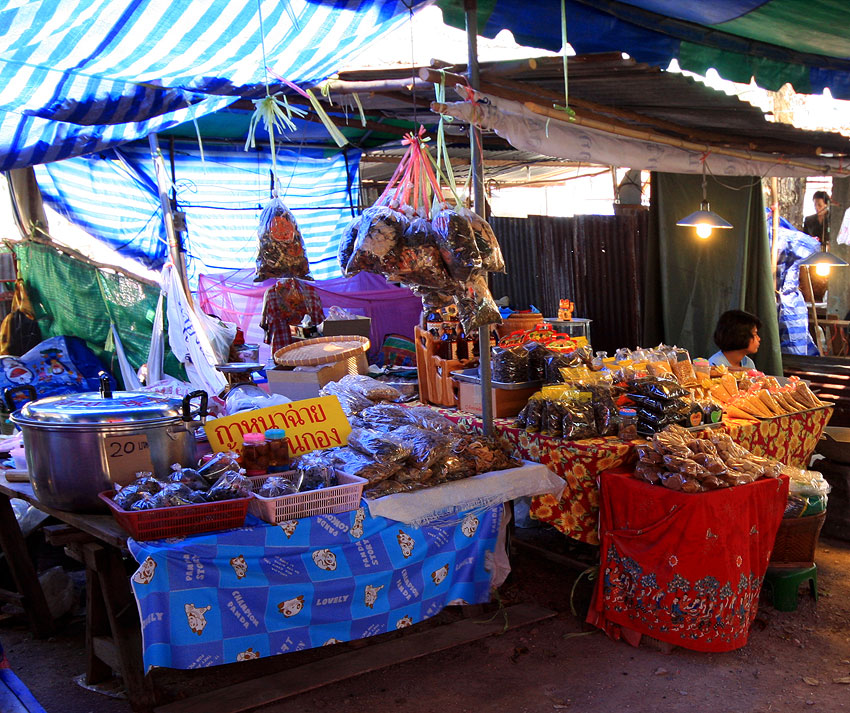
And where do all of the items for sale come from? How did they get here, to this place, today? The Thai market extends as a living, moving web of connections to those who are making, manufacturing, growing, raising, crafting, assembling, producing, processing, carving, painting, pressing, sieving, stuffing, spooling, shaving, stacking, staking, skewering, separating, segmenting, and all of the other incredible variety of activities and movements humans do while in the act of producing. Human Artifacts From The Hands Of Humans For Sale Here.
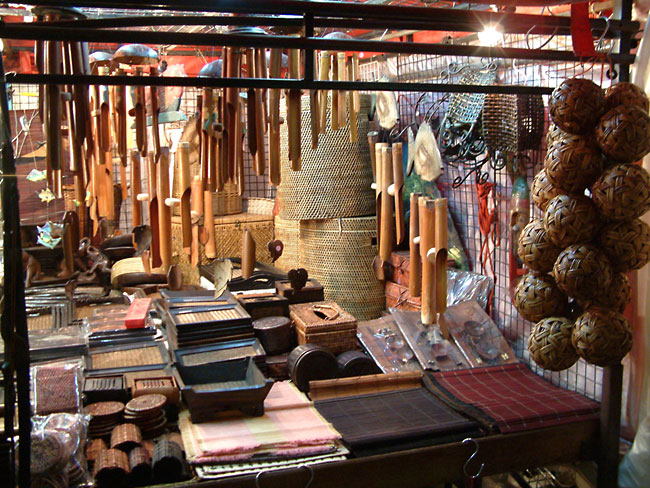
There seems to be something about being in a place devoid of sophisticated marketing ploys and capers (the Sirens of the Purchasing Event) of the modern superstore that enables the market visitor in Thailand to obtain the distance, the estrangement, from the product-without-a-history view of merchandise necessary for a glimpse into the relationship between what is made, who makes it, how it is made, who sells it, and who buys it - of every thing. The clean, white container of Johnson's Baby Powder (astride the squid brochettes) seems, for the first time, made. In contrast to the human environment of the market, the far away big city art-department packaging graphics begin to be recognized as artificially interesting as they really are. The translated Chinese product labels found here are preferred: Happy Future Nails, Good Winning Cherry Blossom Soap. The napkin back and dining room table graphics are perfectly appropriate to the product and the market. The Thai market provides an escape from branding projects. Although it is pecuniary space, it has a face with whom you can interact.
What physically constitutes a market? What counts as a market? Lashed together canoes with pots and chewing gum and whatnot brand fish sauce, certainly. Seven circled food carts at 3:00am, oh yes. Acres of big business man controlled, all under one roof, stalls-for-rent, permanent structure, normally. Four streetside women with nine wash tubs filled with greens, sure. Carnival gold fish in a plastic swimming pool, o.k. A pick-up truck overhung with plastic bags of unidentified fruit, in synchronized sway, squeaking through your moo baan, of course.
There must be politics here. There are stories about bribes, kickbacks, dirty deals, cheats. Who decides who gets the prime locations in the market, and how? Is there turf to watch out for? Are there difficult personalities to watch out for and personages to please. What history of accommodation has forged the daily drill and discipline?

There are orange lines of monks to feed in the morning market who bless the market faithful.
What would it be like to live and work in the market? Every day? For the rest of my life? The rest of my life, how long will that be? The curiosity, questioning, sense-making has no end. The experiences in the market are never repeated. The human interactions are unique every time you go there.
For all the many years I have walked in markets around this planet (Africa, Europe, Egypt, India, China, all of Southeast Asia) I am still always in a swirl of amazement when I go there. The volume on reality seems turned way up. The world here is in fantastic 3-D; in fullest relief. My perception and awareness are in a fine and bold rejuvenating state. To walk the market is to experience a renewal of reverence for being. When you leave the market you take with you something new.
Oh yes, sometimes you go to the market to purchase things.
When I walk the market with my camera I am working. Working at seeing. Working at understanding, using images as the stuff of knowing. Performing the tasks of confirming and undoing presuppositions about what makes up reality (re: doing therapy on my common sense): Adding to and revising old stories and, perhaps, if I allow the perception that only comes with estrangement, making new stories for myself about the way it is. In this I is no different from anyone else walking the market; the tourist, the traveler, the Thai out-of-towner, the local policeman, the under foot child of the petit commercant,or customers on purchasing missions.
The photographs that follow are not necessarily supporting salvos, on behalf of the photographed, in a struggle against oblivion. Instead, they seem more likely to be lessons in how to overcome the compulsion to find pattern in the human fact; visual aids for the teaching of nominalism (there is only the small stuff); advertisements for the supramundane (what The Buddha did), than traditional art-photography visual penetralia (surface can be used to reveal that which is hidden behind surface). They digital Ohs and Ones cast upon Cyberspace. Colored light projected on glass or plastic for the viewer, whether ever having been in Thailand or not, to enrichen the self.
Jeffrey P. Harper, Ph.D.
Pakkret, Nonthaburi, Thailand
April 2002
[In 2001 and 2002 I accompanied the photographer Paul Ubl around Thailand while he took remarkable photographs of the Thai market for his book "A Walk in the Market" which was published in 2002. The preceding is the full text of the forward I wrote for that book, subsequently edited by the publisher. JPH 3/2009]
References (3)
-
 Response: Lifeguard course
Response: Lifeguard course -
 Response: Lifeguard Certification near meAmerican Lifeguard Association
Response: Lifeguard Certification near meAmerican Lifeguard Association -
 Response: Lifeguard CertificationAmerican Lifeguard Association
Response: Lifeguard CertificationAmerican Lifeguard Association
Reader Comments (2)
Makes me really miss the ambience of Thailand. : (
Thanks for sharing your walk, Jeff. Street and weekend markets are where one finds the microcosm, the sense of being in Thailand. In the States, give me the serenity of the forest; in Thailand, give me the market atmosphere.